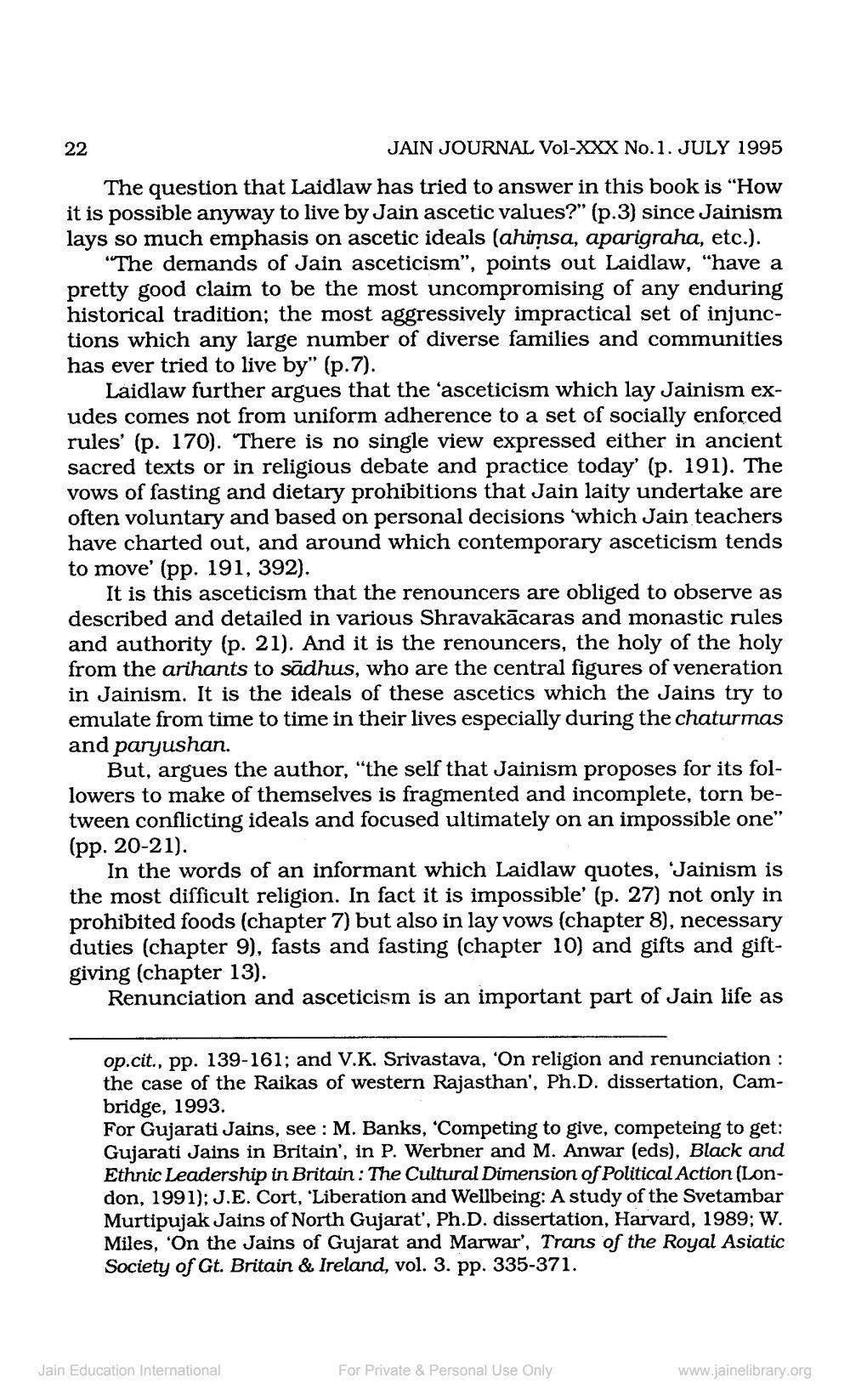Book Title: Jain Journal 1995 07 Author(s): Jain Bhawan Publication Publisher: Jain Bhawan Publication View full book textPage 6
________________ JAIN JOURNAL Vol-XXX No. 1. JULY 1995 The question that Laidlaw has tried to answer in this book is "How it is possible anyway to live by Jain ascetic values?" (p.3) since Jainism lays so much emphasis on ascetic ideals (ahimsa, aparigraha, etc.). "The demands of Jain asceticism", points out Laidlaw, "have a pretty good claim to be the most uncompromising of any enduring historical tradition; the most aggressively impractical set of injunctions which any large number of diverse families and communities has ever tried to live by" (p.7). Laidlaw further argues that the 'asceticism which lay Jainism exudes comes not from uniform adherence to a set of socially enforced rules' (p. 170). There is no single view expressed either in ancient sacred texts or in religious debate and practice today' (p. 191). The vows of fasting and dietary prohibitions that Jain laity undertake are often voluntary and based on personal decisions 'which Jain teachers have charted out, and around which contemporary asceticism tends to move' (pp. 191, 392). It is this asceticism that the renouncers are obliged to observe as described and detailed in various Shravakācaras and monastic rules and authority (p. 21). And it is the renouncers, the holy of the holy from the arihants to sadhus, who are the central figures of veneration in Jainism. It is the ideals of these ascetics which the Jains try to emulate from time to time in their lives especially during the chaturmas and paryushan. 22 But, argues the author, "the self that Jainism proposes for its followers to make of themselves is fragmented and incomplete, torn between conflicting ideals and focused ultimately on an impossible one" (pp. 20-21). In the words of an informant which Laidlaw quotes, 'Jainism is the most difficult religion. In fact it is impossible' (p. 27) not only in prohibited foods (chapter 7) but also in lay vows (chapter 8), necessary duties (chapter 9), fasts and fasting (chapter 10) and gifts and giftgiving (chapter 13). Renunciation and asceticism is an important part of Jain life as op.cit., pp. 139-161; and V.K. Srivastava, 'On religion and renunciation : the case of the Raikas of western Rajasthan', Ph.D. dissertation, Cambridge, 1993. For Gujarati Jains, see: M. Banks, 'Competing to give, competeing to get: Gujarati Jains in Britain', in P. Werbner and M. Anwar (eds), Black and Ethnic Leadership in Britain: The Cultural Dimension of Political Action (London, 1991); J.E. Cort, 'Liberation and Wellbeing: A study of the Svetambar Murtipujak Jains of North Gujarat', Ph.D. dissertation, Harvard, 1989; W. Miles, 'On the Jains of Gujarat and Marwar', Trans of the Royal Asiatic Society of Gt. Britain & Ireland, vol. 3. pp. 335-371. Jain Education International For Private & Personal Use Only www.jainelibrary.orgPage Navigation
1 ... 4 5 6 7 8 9 10 11 12 13 14 15 16 17 18 19 20 21 22 23 24 25 26 27 28 29 30
